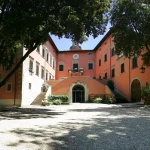This villa has its roots in the first half of the 13th century, when it was built as part of a complex of buildings called the “Castello della Pieve.”
The Serristori family, who inherited some of the local properties from the historic Florentine family of the Albizzi (fierce enemies of the Medici), rented the lands of the estate in the 16th century, mainly vineyards and olive groves owned by the Diocese of Badia Agnano. However, they continued to expand their land holdings, focusing particularly on Pieve a Presciano.
After the castle was conquered by the Florentines, the Serristori family embarked on an important reconstruction project, gradually transforming the structure from a military fort into an elegant villa. During the 17th century, the Serristori family continued to acquire land and properties, and in the first half of the 1600s, a major renovation of the villa took place. The new “Palagio” was constructed by merging several adjacent houses, resulting in an irregular floor plan and varied volumes that lacked the coherent, orthogonal layout typical of the time.
During the 17th century, the Serristori family grew in importance, with members holding political, military, and ecclesiastical positions in the Grand Duchy of Tuscany. At the same time, the estate of Pieve a Presciano expanded, eventually encompassing around fifteen rural houses, thirty farmsteads, and a couple of mills.
A second major renovation took place in the second half of the 19th century, when Alfredo Serristori commissioned the redesign of the villa’s façades and various interior works. The project, attributed to architect Falciani, incorporated contemporary influences from the Florentine villas of the Serristori family. During this renovation, all the windows were replaced, and a double staircase was added between the two wings of the building, leading to an elevated courtyard where a terrace had previously stood.
At the center of the double staircase, beneath a vaulted pediment, was a large French door leading to the main hall on the first floor. A door on the ground floor, beneath the terrace, provided access to the stables and cellars. A small bell tower with a sail was added to the roof. Additionally, the façade of the villa was reversed to emphasize the view of the surrounding countryside, reducing the prominence of the side facing the village. Later, the lemon house (limonaia) was also rebuilt.
Towards the end of the 19th century, the villa was inherited by the Tozzoni family, who were granted permission to retain the Serristori name and noble titles in 1895. Umberto Tozzoni had the garden below the villa created between 1897 and 1899. In 1940, the last heir of the Serristori family, Countess Sofia Serristori nei Bossi Pucci, sold the villa-farm to Arturo Ghezzi, the Podestà of Pergine Valdarno and a descendant of one of the historic families that had owned Pieve a Presciano.
Today, the property belongs to the Petracchi family. In addition to the Villa Serristori, the “La Pieve” estate encompasses vast agricultural lands, vineyards, and olive groves, all of which are carefully cultivated with dedication by the family.
An interesting and fascinating detail about the entrance hall of the palace is that it was the location of a historic local vote in 1859, when the plebiscite was held to determine the annexation of the Grand Duchy of Tuscany to the Kingdom of Italy. This event played a significant role in the unification of Italy, and the very place where it occurred is a reminder of the region’s pivotal contribution to the nation’s history.




